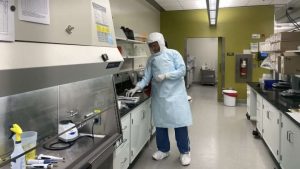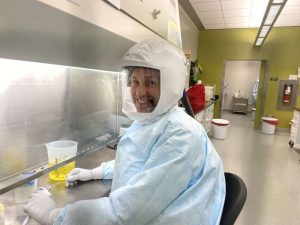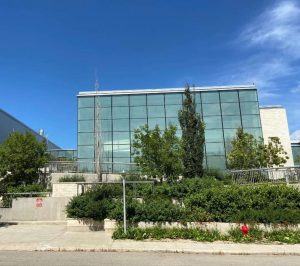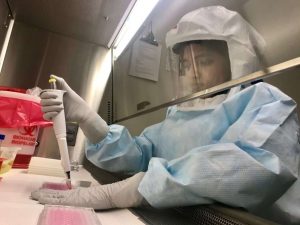Made-in-Canada COVID-19 vaccine effort slowed by manufacturing delay

In early February, a tiny tube of yellow-tinged liquid was packed into a sealed container designed to withstand an airplane crash.
The sample was from the first Canadian case of COVID-19, and destined for the University of Saskatchewan campus in Saskatoon, where research scientists were mobilizing their efforts to develop a vaccine.
At the time, the Vaccine and Infectious Disease Organization-International Vaccine Centre (VIDO-InterVac) was one of only a handful of labs around the world working on a potential COVID-19 vaccine.
The team, which is now one of more than 160 research groups around the world working on a vaccine, set an incredibly tight timeline considering vaccines usually take around a decade to get approval.
VIDO-InterVac’s plan, if trials were successful, was to have a vaccine ready to manufacture for targeted groups — such as front-line workers — by March 2021.
But now, despite long workdays and promising early results, the team says a lack of manufacturing capacity is slowing down their efforts at a made-in-Canada vaccine — something that matters given concerns over “vaccine nationalism,” which could prevent access to a product that’s not made at home.

A typical day for director Volker Gerdts could begin with a meeting with the World Health Organization as early as 6:30 a.m. CST and end as late as 10 p.m. with a call to China.
“We all sense the urgency and the importance of our work and so it’s hard to explain to yourself taking time off when people are literally dying in the hospital,” said Gerdts in June.
“We have a really good team … however burnout is a real thing.”
Early test results were good. Ferrets given the vaccine candidate showed a strong immune response to COVID-19, generating antibodies and having a decreased viral infection.
Regardless of the encouraging signs, the researchers were always at the mercy of external factors like global politics and manufacturing capacity. Now, Gerdts says the timeline of a VIDO-InterVac vaccine being ready to manufacture, if it’s successful, has been delayed by both.
Before it can proceed to human clinical trials, the facility needs to complete more studies using higher-grade materials than what they needed for their early animal studies. But waiting for busy manufacturers to provide them is holding up the process.
Had the federal government invested more in a proposed manufacturing facility at VIDO- InterVac before the pandemic, Gerdts said, a Canadian vaccine would be at the front of the race.
“We’ve been telling the government, and I don’t want to use this as a blaming, but we have raised the issue of Canada’s unpreparedness for pandemic diseases for quite a while,” Gerdts said. “You need to have manufacturing capacity. You need to have the ability to quickly respond.”
CBC News asked the federal government why it didn’t invest more in manufacturing at VIDO-InterVac before 2020, and whether it feels it did enough to prepare for a potential pandemic before COVID-19.
“The health and safety of Canadians is the Government of Canada’s top priority,” said part of a statement from Innovation, Science and Economic Development Canada in response.
“That’s why the government is mobilizing Canada’s world-class researchers to deliver rapid responses to fight COVID-19.”
Inside the lab
Darryl Falzarano’s work day begins with a series of biosecurity protocols including changing his clothes twice, showering and going through a secure corridor.
He works in the Level 3 high containment lab with SARS-CoV-2 — the virus that causes COVID-19 — and other viruses. His uniform includes a face shield and a head covering that pumps clean air around his face. He puts duct-tape around his wrists where his gloves meet the sleeves of his suit.

Falzarano said people ask him if he is scared about working in containment labs.
“For myself, that’s not the case,” he said.
“Of course you’re working with a pathogen that can infect you and in some cases cause a … high fatality rate, but being fearful, that’s not the right attitude to have.”
Falzarano, who is also working on a vaccine for the MERS coronavirus in camels, needs to prepare samples of SARS-CoV-2 for what the researchers called “challenge” studies.
The study involves giving ferrets or hamsters two doses of the vaccine over a period of two months. After that, the animals are infected with the virus. The scientists then monitor the infected animals to see how well they are protected by the vaccine.
The VIDO-InterVac vaccine is made with the spike protein on the outside of SARS-CoV-2. If successful, it would work by using that protein to trick the immune system into thinking it has COVID-19 so it will generate the antibodies and T-cells that fight the virus.
To make it, the researchers grow the spike protein in human cells then combine it with an ingredient called an “adjuvant,” which kicks the immune system into even higher gear.
To test the vaccine, VIDO-InterVac identified ferrets and hamsters as the animals who experience the effects of the virus most like humans.
The researchers said ferrets tend to be infected most strongly in the upper respiratory tract. The vaccinated ferrets had a strong immune response to the virus.
But the researchers wanted their tests to show the vaccine also reduces the amount of virus in the lower respiratory tract: the lungs. Hamsters were better suited to show that effect.
In late July, the researchers learned the experiment involving the hamsters, which takes two months, would have to be repeated to try a higher dose of the virus.
The researchers said the vaccine also generated an immune response in the hamsters, but not as consistently as it did in ferrets.
Falzarano said that, despite the tight timeline, he has to filter out the pressure that comes with working on a vaccine the world is waiting for.
“I don’t feel that so much. I actually think that’s a bad thing that leads you to want to cut corners or, you know, look at potentially your data differently,” he said.
“I think it’s very important that doesn’t happen.”
Manufacturing creates delays
In June, Gerdts laid out his ideal timeline for progressing to human clinical trials and then manufacturing, if all went well: begin manufacturing in the new year to have 10-20 million doses by March or April 2021
But now, he expects manufacturing to begin in June 2021 at the earliest.
The researchers need higher-grade ingredients to prepare the virus for an essential phase of the animal testing process and to proceed to human clinical trials, but have been unable to get those ingredients manufactured by suppliers without delays.
A vaccine must go through three phases of human clinical testing to be approved.
The first involves one to 100 volunteers and the second phase involves 20 to 500. The third and final phase traditionally takes years, as up to 30,000 volunteers are vaccinated and the researchers wait to see how the vaccine works in volunteers who happen to get infected.
Concerns are already being raised by some scientists about demand for the vaccine outweighing the capacity to manufacture it around the world.

VIDO-InterVac is in the process of building a pilot manufacturing facility, but it is not scheduled to be ready until the end of 2021.
The facility received an initial $3.6 million from the federal government in 2018. Even before the pandemic, VIDO-InterVac leaders were trying to get more funding, but an additional $12 million that allowed the facility to start construction didn’t come until March. The facility also received $23 million to develop the vaccine.
Gerdts said his team could now be as far along the approval process as front-runners like Oxford University/AstraZeneca and Moderna vaccines, neither of which are Canadian, if the funding had come earlier.
Earlier this month the federal government made a deal to purchase millions of doses of the Pfizer and Moderna vaccines, saying it is still considering similar deals with other developers.
Gerdts said not having the manufacturing facility has created delays for his team.

“It is the unfortunate reality and it is disappointing because we have kind of predicted this to happen,” said Gerdts.
“We need to have a manufacturing facility and when this thing hits you need to be able to quickly respond, and all in-house so that you don’t have to go outside and hire others.”
He said that manufacturers elsewhere are understandably busy now.
“So you can’t just simply expect that a manufacturing facility stops all what they are doing now to produce your vaccine.”
Andrew Casey from BIOTECanada, an association that supports the vaccine industry, said Canada’s capacity to manufacture an eventual vaccine will depend on what type of vaccine it is, and how closely it resembles ones that have been gone before.
The ease of manufacturing, and the time and cost of doing so, could also play a role in which Canadian vaccine, if any, is finally made available to the public, he said.
Emergency fast-tracking seems less likely: Gerdts
A June start-date for manufacturing would only be possible if Health Canada granted an emergency authorization to allow some manufacturing for at-risk groups — like seniors and healthcare workers — before Phase 3 of human clinical testing was complete.
Gerdts said he originally thought that was a strong possibility, but that it seems less likely now. Russia’s decision to start using a vaccine without completing Phase 3 was not well received by many scientists.
“We haven’t really seen any of the governments saying under an emergency authorization we want this to be used earlier,” Gerdts said.
“I think there is a concern in the public that some of these vaccines are maybe not safe enough, because they were developed too quickly.”
Gerdts said he is not concerned about others getting to make a vaccine first, because the world needs multiple vaccines with different abilities. But losing momentum, he fears, could lead the government to invest in other vaccines that are progressing faster, potentially from international companies outside Canada.
Gerdts said the team plans to continue pushing forward with its vaccine with as much urgency as it had at the start of the pandemic.
“I think the scientist in me says I have a better vaccine than many of these vaccines that are out there right now and that’s really — our results show that,” said Gerdts, who has tested some other vaccines.
He said he expects some vaccines to start coming out early next year, but they may not be as effective as people want.
“Then there will be a second round of vaccines coming forward which will be better than the first round,” he said.
“Ours will be one of those.”
CBC





Redes Sociais - Comentários